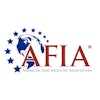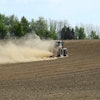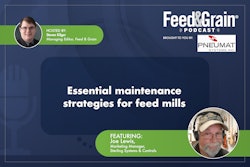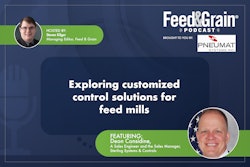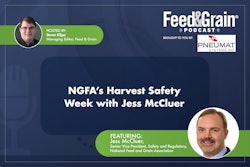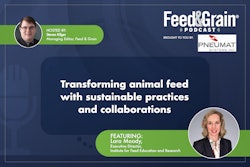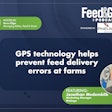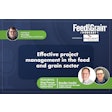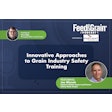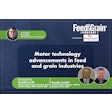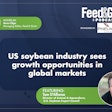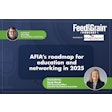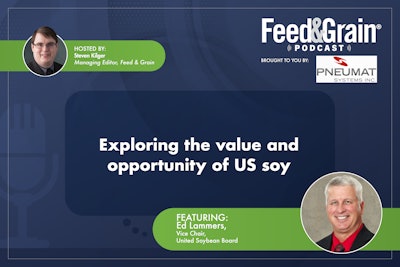
View on Zencastr
In this episode of the Feed & Grain Podcast, host Steven Kilger sits down with Ed Lammer, a fifth-generation soybean farmer and Vice Chair of the United Soybean Board. Together, they explore the exciting initiatives and substantial budget of the United Soybean Board, which is dedicated to advancing the soybean industry. Ed discusses the board’s mission to provide soy solutions for everyday life, highlighting groundbreaking projects in artificial intelligence, sustainable agriculture, and infrastructure. He also delves into the impact of these innovations on the global soybean market and how farmers can get involved in shaping the future of their industry.
Steven Kilger - 00:01
Hello, my name is Steven Kilger and I'm the Managing Editor of Feed & Grain and the host of the Feed & Grain podcast. Thank you so much for joining me today as we dive deep into the issues affecting the feed manufacturing, grain handling, and allied industries.
Today's episode is brought to you by the BinWhip from Pneumat Systems. The powerful dual impact BinWhip removes the toughest buildup and blockages in industrial storage silos — without hazardous silo entry. Learn more today at binwhip.com.
Today I'm talking with Ed Lammer, soybean farmer and United Soybean Board Vice Chair. We talk about the United Soybean Board's largest-ever budget, projects that the board is working on, and the importance and value of getting involved in advocating for your industry.
I hope you enjoy the interview. If you want to help with the podcast and are listening to this in a podcasting app, please rate us and subscribe. If you're listening online, sign up for the Feeding Grain newsletter, Industry Watch, to see the new podcast job and stay up to date with all the news from around the industry. Now onto the show.
Hi Ed, thanks for joining me today.
Ed Lammer - 01:07
Good morning.
Kilger - 01:08
Hello. I'm happy you're here. Can you give me a little bit of an overview, kind of who you are, and your relationship with our industry?
Lammer - 01:15
Yeah, so I'm Ed Lammer. I live in the northeast part of Nebraska, and I am a fifth-generation farmer. We raise soy, corn, alfalfa, and some rye. We currently have about 200 head of stock cows that we raise the babies of and then we take them to harvest. And when I say we, my sons are involved in the operation also and have kind of gone out in that endeavor and selling the beef privately to individuals. And it's been a great asset to our operation. I've been on the Nebraska Soybean Board for six years and now this is my eighth year on the United Soybean Board. I'm currently the vice chair of the 77-member board.
Kilger - 02:02
It always amazes me you have this big operation you're obviously working on the farm and then to also devote your time to a board into advocating for your industry is always kind of amazing to me that you find the time to do it if nothing else.
Lammer - 02:19
Well, it's a great opportunity. I mean, it does have its challenges, don't get me wrong, but it is the opportunity to learn and grow and to be more aware of and then also to be a voice in the development of projects or demand or research or education. That's just a great opportunity and a growing opportunity for myself.
Kilger - 02:42
Well, I mean, we're glad you did it. So I have you on here to talk a little bit about the United Soybean Board and your mission. You guys just had a big meeting where you passed your budget for 2025. And it sounded like a pretty exciting time because you guys are really going all in. You're investing a lot in the industry this year. Can you tell me a little bit more about the United Soybean Board's mission and what its impact is in kind of soybean commodities? What is out there in the US market?
Lammer - 03:12
Yeah, so our mission statement actually is to provide soy solutions to every life, every day. So that's quite a statement and to achieve that you have to be in certain aspects of marketing, development, production, transportation, education, and best management practices. It's a wide variety. Opportunities and to achieve all those opportunities we have actually eight working groups. The three main ones are innovation technology, health and nutrition, and infrastructure and connectivity. And on all three of them, there's a supply which you can think of the supply being anywhere from the development of a seed or a seed germ To the delivery of the mass product, soybeans, to the elevator. And then the demand side is anywhere from that delivery point to the elevator to the very end product.
Whether it's soybean oil, soybean meal, soybean hulls, or even as far as biofuels, soy foam, fire-resistant soy foam, tennis shoes, asphalt, and grass turf, There are over a thousand products that Soy is involved in and it's just a really wide variety and that's part of the beauty of being involved and trying to understand and be educated on what I am doing here on my farm that influences customers worldwide and that's exciting.
Kilger - 04:53
Yeah, it is. It is a very global impact that farmers here in the U.S. we're in, I'm in Wisconsin. So we're surrounded by soybean fields. And every time you drive by, you're like, yeah, that corn, that soybean that might end up across the world feeding people in other countries. And that's pretty amazing when you really think about it. Can you talk a little bit about some of the projects and innovations that the United Soybean Board will focus on this coming year, especially with this big budget being passed?
Lammer - 05:23
Yeah, absolutely. A $170 million budget is substantial, right? So with all those opportunities, the directors are focused on some new projects this year, like artificial intelligence and the tools that become available with that. And then also how that can affect our sustainability score, and our lower carbon footprint scores. So we're kind of busy collecting that data. And how that can be positive for U.S. soy producers. Other things are infrared and spectrum imaging of the soybean grading systems.
To quote one of the workgroup leads, he's saying, we're going to try to be more precise on our grading. We'll try to eliminate the human uncertainty or not consistent. We're looking into that value, which that would bring to the U.S. producers. And then not only them, but for all the value chain down the line whether it's the elevator or the processors or the food companies that use our products. So that's basically in the infrastructure connectivity. Also, we've done some dredging. In multiple ports, we've done an expansion at Port Grays Harbor, that's out on the West Coast, and St. Lawrence Seaway, Lock and Dam 25, and then also the lower Mississippi.
Now, we didn't do the dredging, but we collected the data that was needed by those partners that we are involved with to get the information that is needed to make a good decision. And that's all in that one workgroup. Now, in the health and nutrition workgroup, you know, we both have the supply and demand on both of these workgroups. In health and nutrition, we look at soybean meal. There's been an added crush capacity in the United States and most of that's being driven by soybean oil. So with the demand for soybean oil, we're having more meal and when you take the soybean about 80% of it is soybean meal and the other is oil. So that demand for oil has caused more meals to come on the market and we've been doing some studies and research that We are finding health benefits in swine diets by increasing the inclusion rate of their diets.
And that's really exciting and we can see efficiencies in poultry and pork with those higher inclusion rates. Also, we are looking at Biotech traits and genetics in high oleic oil, it's not a commodity bean, but it's a really exciting bean that where it does a lot of health benefits, has environmental benefits that are better than our commodity beans. So with those bio traits and genetics, we're trying to get more ranges in the maturities. You know in the United States we produce soybeans in North Dakota and Texas so the environment's a little different in those two areas so we need all those varieties to try to fit in the regions where production is being made. You know, and then I talked a little bit about the biofuels, you know, that's been exciting, been real positive for U.S. soybean producers. We're really hopeful that we continue with that, whether it's in biodiesel renewable fuels or even sustainable aviation fuel. Think it was last year, biodiesel and renewable fuels were used in 8.9 billion gallons.
Well, this year we're looking at 12.8 billion gallons, that's a pretty good increase and that is some of the reason why we're having more crush capacity being domestically crushed here in the United States. So also with some of those in this here health and nutrition area, on the supply side we're trying to manage pests. Whether it's slugs or soybean cyst nematode, that's in a region you know out in the east and northeast where it's really a hard pest to kind of manage. You really never know when you're going to get them. You kind of anticipate it but it's not a for sure thing. Also, other things like deer coming in from the wooded areas and consuming the soybeans when farmers plant. There's a technology out there that you might be able to plant like the outside 12 rows that don't taste as good to those deer so they won't come into the field and consume the rest of it.
So, you know, just little things like that we're looking at and trying to develop just to enhance those producers' production. We're building demand and we're building our production. We want to have the production for the demand that we're building and we're looking at many things to achieve them, whether it's pests, benching pests across different soil types, tillage methods, times of application, soybean aphids, you know, we generally have that and we need to know when it's most optimum to be In Infrastructure and Connectivity, we talked about Soy-based Circulum, which soy-based chemistry is being developed for post-secondary students in trying to train the future of the workforce to be interested in animal ag or ag in general. Also, export, so that's the other one that one of the other work groups we have an export promotional group so they are investing soy producers check-off into soybean meal whole soybeans we used to try to look into oil but now we have that domestic oil Demand here, we don't really look as hard to export oil, but we look at meal and whole soybeans, but then we also look into that value-added perspective where we have animal ag production in the United States, whether it's poultry or pork, we support USMEF, which is United States Meat Export Federation, they export pork, beef, and lamb, and then we support the USAPEC, United States Poultry Export Council, and we help support them exporting poultry around the world or finding new markets to export into.
Also, USEC is a major partner of ours where they're the United States Soybean Export Council, which emphasizes the meal and The soybean in itself. So then the other work group that I haven't talked about yet is our communication education work group which takes our ideas or our projects and shares them through the target areas that they feel a certain topic would be most effective. Or the most education, whether it's to farmers or customers that live in the urban cities.
So that area is interesting in itself. It's hard to get a grasp on how United States soybean producers can touch and have a difference, make a difference in customers' lives throughout the world and in the United States. So, you know, there's one thing we really, we really monitor really well at United Soybean Board and that's the return on our investment. So every dollar that we invest, whether it's in any of these work groups, the average return on investment's been $12.34.
Now we're doing a new return of investment over the last five years where that study is going to be out here, oh, I think within a couple of months. But so far what we've seen is going to be very similar to the last return on investment study we did. Now I don't want to confuse anybody but some work groups are higher in the return on investment than others and I just want to make sure everybody understands that the board looks at this. We monitor that so for instance some work groups it's harder to Put a value on an education for a producer that might or might not bring back a higher return on investment, but that producer may utilize that to become more productive, more sustainable, and lower the carbon footprint.
So there are great attributes there that can't always be monetarized. So, but overall $12.34 on every dollar investment. That's pretty remarkable. And we foresee that keep that going in that direction in the future.
Kilger - 13:52
Yeah. I mean, it's a really exciting time to be in the soybean industry.
It really is. I mean, there's a lot happening and how can people Who are interested kind of get involved in what the United Soybean Board does? How do you get on committees? Where can you donate some money? Where can you do all these things?
Lammer - 14:11
The best spot to start probably would be to go to the website unitedsoybean.org and look for opportunities there. There are other opportunities. You can even go to your extension office and receive information. You can go to your local county organizations or associations. You also have their state QSSBS. You can also get involved at the United States Soybean Board. So there's an election there.
It happens in the state of Nebraska, there are nine directors on the state QSSB. And then Nebraska has four directors on the United Soybean Board. And that's a nomination from the Nebraska State Board. You can put your nominations in there for a seat on the National Board. And then the state will bring forward two names and that goes in front of the secretary ag and then the secretary ag chooses a name of the two to be the director. I really would encourage everybody just to get involved locally, state-wise, nationally, wherever you desire or you see an opportunity. It's challenging, but yet it is so rewarding.
You learn so much. It's just a great opportunity and puts you in places where you better understand the world and how it all works and the infrastructure, the production, the processors, and all that. It's a bigger, broader picture when you get more involved.
Kilger - 15:45
Yeah, definitely. Well, thank you so much for joining me today, Ed. I really appreciate it. And I hope you'll come back again as you guys start to get some of these projects out and we can talk a little more detail about them.
Lammer - 15:56
Awesome. That sounds great, Steven.
Kilger - 15:58
And everyone out there, thank you so much for listening. Until next time, stay safe.
.jpg?auto=format%2Ccompress&crop=faces&fit=crop&h=48&q=70&w=48)
